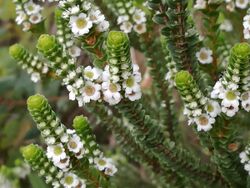Biology:Baeckea imbricata
| Heath myrtle | |
|---|---|

| |
| Baeckea imbricata at Palm Beach | |
| Scientific classification | |
| Kingdom: | Plantae |
| Clade: | Tracheophytes |
| Clade: | Angiosperms |
| Clade: | Eudicots |
| Clade: | Rosids |
| Order: | Myrtales |
| Family: | Myrtaceae |
| Genus: | Baeckea |
| Species: | B. imbricata
|
| Binomial name | |
| Baeckea imbricata (Gaertn.) Druce[1]
| |
| Synonyms[1] | |
|
List
| |
Baeckea imbricata, commonly known as heath myrtle,[2] is a species of flowering plant in the family Myrtaceae and is endemic to eastern Australia. It is a shrub with elliptical to egg-shaped or round leaves and small white flowers with five to twelve stamens.
Description
Baeckea imbricata is a shrub that typically grows to a height up to 1.0 m (3 ft 3 in), sometimes to 1.6 m (5 ft 3 in) , and has flanged branchlets and grey, scaly bark. The leaves are elliptical to egg-shaped or round, 2.5–5.4 mm (0.098–0.213 in) long and 2.0–3.9 mm (0.079–0.154 in) wide on a petiole up to 0.3 mm (0.012 in) long. The flowers are 4.0–4.5 mm (0.16–0.18 in) in diameter and are borne singly in leaf axils, each flower on a pedicel usually 0.3–0.8 mm (0.012–0.031 in) long with bracteoles 1.5–2.5 mm (0.059–0.098 in) long that often persist until the flower opens. The sepals are oblong, 0.7–1.2 mm (0.028–0.047 in) long and the petals are white, more or less round and 1.4–1.6 mm (0.055–0.063 in) long. There are five to twelve stamens in groups of up to three. The ovary has two locules and the style is about 1 mm (0.039 in) long. The fruit is an oval capsule about 2 mm (0.079 in) long.[2][3]
Taxonomy
Heath myrtle was first formally described in 1788 by Joseph Gaertner who gave it the name Jungia imbricata in De Fructibus et Seminibus Plantarum.[4][5] In 1917, George Claridge Druce changed the name to Baeckea imbricata in the supplement to The Botanical Exchange Club and Society of the British Isles Report for 1916.[6][7] The specific epithet (imbricata) means "overlapping".[8]
Distribution and habitat
Baeckea imbricata grows in heathland in swampy places in near-coastal areas and on adjacent ranges from Cooloola National Park in south-eastern Queensland to Bawley Point in south-eastern New South Wales.[3]
References
- ↑ 1.0 1.1 "Baeckea imbricata". https://biodiversity.org.au/nsl/services/apc-format/display/104469.
- ↑ 2.0 2.1 Wilson, Peter G.. "New South Wales Flora Online: Baeckea imbricata". Royal Botanic Gardens & Domain Trust, Sydney, Australia. http://plantnet.rbgsyd.nsw.gov.au/cgi-bin/NSWfl.pl?page=nswfl&lvl=sp&name=Baeckea~imbricata.
- ↑ 3.0 3.1 Bean, Anthony (1997). "A revision of Baeckea (Myrtaceae) in eastern Australia, Malesia and south-east Asia". Telopea 7 (3): 253–254. doi:10.7751/telopea19971018. ISSN 0312-9764.
- ↑ "Jungia imbricata". APNI. https://id.biodiversity.org.au/instance/apni/459139.
- ↑ Gaertner, Joseph (1788). De Fructibus et Seminibus Plantarum. 1. Stuttgart. p. 175. https://www.biodiversitylibrary.org/item/114363#page/373/mode/1up. Retrieved 23 January 2022.
- ↑ "Baeckea imbricata". APNI. https://id.biodiversity.org.au/instance/apni/533429.
- ↑ Druce, George C. (1917). "Nomenclatorial Notes: chiefly African and Australian". The Botanical Exchange Club and Society of the British Isles Report for 1916, Suppl. 2 4: 608. https://www.biodiversitylibrary.org/item/195177#page/680/mode/1up. Retrieved 23 January 2022.
- ↑ Sharr, Francis Aubi; George, Alex (2019). Western Australian Plant Names and Their Meanings (3rd ed.). Kardinya, WA: Four Gables Press. p. 222. ISBN 9780958034180.
Wikidata ☰ Q15400952 entry
 |

